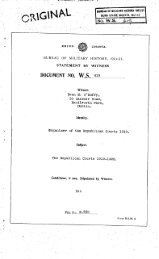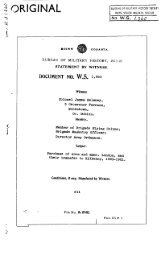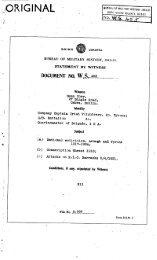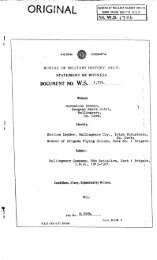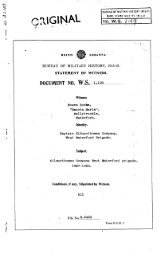ROINN COSANTA. BUREAU OFMILITARY HISTORY, 1919-21 ...
ROINN COSANTA. BUREAU OFMILITARY HISTORY, 1919-21 ...
ROINN COSANTA. BUREAU OFMILITARY HISTORY, 1919-21 ...
You also want an ePaper? Increase the reach of your titles
YUMPU automatically turns print PDFs into web optimized ePapers that Google loves.
<strong>ROINN</strong><strong>COSANTA</strong>.<strong>BUREAU</strong> OF MILITARY <strong>HISTORY</strong>, <strong>1919</strong>-<strong>21</strong>STATEMENT BY WITNESS.DOCUMENTNO.W.S. 1455WitnessJamesO'SullivanRockVillas,Bantry,Co.Cork.IdentityO/C,BantryCompany, Bantry Battalion,Brigade,CorkI.R.A.IIISubject.Activities of Bantry Company, BantryBattalionCork III Brigade,Irish Volunteers, 1917-1922Conditions, if any, Stipulated by Witness.Nil.FileNoS.2766.Form B.S.M.2
STATEMENT BY JAMES O'SULLIVAN,Rock Villas, Bantry, Co. Cork.I was born at Glengariff Road, Bantry on June 20thl900 and was educated at Bantry National School. InAugust, 1914, I entered the Postal Service in Bantryas a telegraph messenger. In a short time I qualified asa telegraphist. I was then employed as Sorting Clerkand Telegraphist in Bantry Post Office, where I serveduntil January, 1922.I joined the Irish Volunteers in Bantry in June,1917. At that time there were only seven or eight menin the Bantry unit. As far as I can recollectthese were: Ralph Keyes, Michael Harrington, Paddy Lynch,Robt. Lynch, Michael Coakley Michael Walsh, TimO'Sullivan, Tom Walsh and James O'Sullivan (witness).The strength of the unit, grew by degrees and before theend of 1917 the strength had increased to about fifty.The officers of the company at this time were:0/C Ralph Keyes1st Lt. Robt. Lynch2nd Lt. Michael CrowleyAdjt. Michael HarringtonQ/M Jack 0'Mahoney.The training of the company, which consistedmainly of close order foot drill and marching in formation,was carried out under our own officers in the fields inthe vicinity of the town. Parades were held twice eachweekIn addition to our normal training and parades,all Volunteers at this period were interested in theorganisation of the political side of the Republican
2.movement Sinn Féin. As a matter of fact, this.organisation was mainly composed of Volunteers,together with a few supporters who were too old to servein the military side. One of our first organisedactivities took place during the summer of 1917, whenthe members of the Bantry Company seized about 100 gallonsof petrol in tins from the local oil depot and sent itto East Clare to help in the transport for theelectioneering work during the by-election therewhen Eamon de Valera was first elected to the Dáil.There was a big increase in the strength ofBantry Company in the spring of 1918, when the Britishthreatened to enforce conscription in Ireland. At thistime the majority of the men of military age in the areajoined up. The strength of the unit was, I'm sure, inthe neighbourhood of 150/200. There was no change inthe company officers. I think that a reorganisationof the Volunteers throughout the area took place at thisstage and that Bantry area was organised on a battalionbasis. As far as I can recollect, the names of thefirst officers of the Bantry Battalion were:0/C Dan O'MahoneyVice. 0/CAdjt. Ted O'SullivanQ.MBantry Battalion was made up of the following companies:Bantry, Comhola, Kealkil, Glengariff, Durrus Caheragh,Kilcrohane and Droumsullivan.. The battalion was the 14thBattalion, Cork Brigade.During 1918 all arms were to be surrendered tothe R.I.C. so the members of Bantry Company raided allhouses where arms were known to be held and seized them.
3.The arms obtained were mainly shotguns, to the number ofabout a dozen. They were dumped in Baurgorm area.Similar action was taken byan other units in the battalionSometime during March, 1918, several members of the unit(Bantry) took part in a raid for explosives at thebarytes mines in Derrygrinaugh. A large quantity ofgelignite, together with fuse and detonators, was obtainedin this raid and removed to a safe dump. Theseexplosives were later used in the manufacture of mines andbombs. As I was specifically detailed for intelligenceduties at this time, I was not permitted to take an activepart in the public activities, of the company.There was no unusual activity in the area inconnection with the general election in December, 1918,as the Sinn Féin candidate for the area Seán Hayes wasreturned unopposed. However, the overwhelming successof Sinn Féin throughout the country gave a boost to theVolunteer organisation, which gradually grew strongerand more determined from now on.Early in <strong>1919</strong> Cork Brigade, which consisted of sometwenty battalions and extended over Cork County. wasdivided into three. brigades. Bantry Battalion nowbecame a unit of a new brigade Cork 111 whichcontrolled West Cork area. The other battalions in thebrigade were: Bandon, Dunmanway, Clonakilty, Skibbereenand Castletownbere. The first Brigade 0/C was Tom Hales,but I cannot recollect the names of the other officers.Normal training continued throughout <strong>1919</strong>, andabout August I was appointed Adjutant of the Bantry Companyas Michael Harrington was appointed to a post on theBattalion Staff about the same time. Con O'Sullivan wasappointed Q/M, as the previous holder of the post Jack
4.O'Mahoney had left the district. The officers ofBantry Company now were:0/C Ralph Keyes1st Lt. Robt. Lynch2nd Lt. Michael CrowleyAdjt. James O'Sullivan (witness)Q/M Con O'Sullivan.The first major activity undertaken by themembers of Bantry unit was carried out on November 17th<strong>1919</strong>, when about a dozen men from the company under theBattalion Vice O/C (Mossy Donegan) and Company 0/C (RalphKeyes) raided a British Naval M.L. boat, No. 171,which was tied up at Bantry Pier near the railway station.These boats, which were employed as submarine chasers,andwere based on Bantry forsecurity reasons, normallyanchored some hundred yards from the shore. in Bantry Bay.However, the officer in charge of this boat decided,against the advice, of the local R.I.C., to tie up at thepier. This procedure had been followed for some time,and each time the boat was in port the movements of theofficers and crew were noted by a Volunteer McCarthyemployed on the steamboat "Princess Beara1t" which pliedbetween Bantry and Bere Island. These reports wereconsidered by the officers of the company and MossDonegan (Battalion V/C), and eventually it was decided toattempt the raid on Sunday night, November 17th <strong>1919</strong>.About ten members of the company, including Ralph Keyes,Seán Cotter, Michael O'Callaghan, Jack Teehan and MossyDonegan, assembled in the vicinity of the railway stationabout 8 p.m. They were armed with two 38 revolvers anda few rounds of ammunition. Two men were delegated towatch the movements of the enemy patrol which usuallymoved about the town, while four others were to stand by
5.to assist in removing any arms that might be availableshould the raid be a success. Four men Ralph Keyes,Moss Donegan, Seán Cotter and Michael O'Callaghanstrolled slowly on to the pier in pairs. They kept aclose watch on the sentry on duty aboard the M.L. boat,and as they drew near they saw him go below decks to thecrew's quarters. The four I.R.A. men, with Moss Doneganleading, then crept aboard the boats and the leader(Mossy Donegan from the top of the companionwaycalled on the crew to put up their hands. While he hadthe crew under cover, his comrades (Ralph Keyes, SeánCotter and Michael O'Callaghan) dashed to the magazineand burst in the door with a sledge, which had beencarried along by the men who had been standing by near therailway station. The armoury contained six RossCanadian rifles, four revolvers, 2 Verey Light pistolsand a large quantity of ammunition. All stores wereremoved, and warning the crew not to move for at leastan hour, the raiding party withdrew round the northernand eastern side of the town to the spot selected fordumping the captured material the national school.However, they were unable to dump the arms in the schooland had to take them to the church nearby, where theywere dumped for the time being with the co-operationof Ralph Keyes's father, who was sexton there at the time.In December, <strong>1919</strong>, I took part in a raid for armson Roycroft's Stores, Main St., Bantry, in which weobtained three hundred cartridges, a large supply ofblack powder and two cartridge filling machines. BantryCompany was a very active unit at this period. Themembers were continuously engaged on raids on enemy storespassing through to the enemy garri5on at Bere Island and
7.operating morse signalling equipment and the sending andtaking of messages. Some of these men whose names Ican remember were: Paddy Connolly, Michael O'Sullivan,Michael Connolly. These men were later to prove mostefficient when placed in listening posts where the wireshad been tapped.Several members of Bantry Company carried out araid on the goods store at Bantry Railway Station in thesummer of 1920. In this raid we obtained a considerablequantity of army stores which were being despatched toBere Island garrison. The goods seized included boots,shirts underwear and socks. They were removed via TheStrand to a dump in Newtown area, where they were storeduntil they were removed to another district fordistribution to the Brigade Column. About the same timewe carried out a raid on the steamboat plying betweenBantry and Bere Island "Princess Bean" in which wesecured a large supply of cigarettes, bacon and tinnedfoods which were on their way to the enemy garrisons atBere Island and Castletownbere. These were also dumpedand later distributed to the column. I was in chargeof these operations. Others who took part were:Patrick Lynch, Michael Coakley, Jerh. O'Sullivan,Michael Walsh and Michael O'Sullivan.The Company 0/C (Ralph Keyes) was "on the run"at this time. I was acting for him in September, 1920,when I received a message from a bread-van driver ConLynch that a. convoy of mule carts carrying rifles anda Lewis gun was on its way from Castletownbere to Bantry.He informed me that he had passed the convoy betweenBallylickey and SnareBridge about four miles from the
8.town. I immediately mobilised the company (Bantry>and Within about thirty minutes had up to forty men atDonemark Bridge about 1 mile from Bantry. I sent asection of six men to the nearest dump at Wilkinson's Woodabout two miles away to collect some arms, but beforethey got back the convoy had passed on its way to Bantry,so the opportunity was lost.In the autumn of 1920 a "listening in" stationwas established at Gortnavallig, about five miles fromBantry on the Glengarrif road. The telegraph wiresbetween Bantry and Castletownbere were tapped and leadstaken into sounders, which were installed in a cave atthis point. This post, from date of establishment,was staffed round the clock by Paddy Connolly, MichaelConnolly and Michael O'Sullivan, who worked in shifts.The establishment of this post enabled our Intelligenceservice to get first-hand information regarding enemy planson a number of occasions. In addition to the post atGurtnavallig, we had a secret telephone Installed in thehome of the Resident Magistrate (Mr. Brady) at Ballylickey.In this case the telephone was installed in Order toenable a member of Cumann na mBan who was employed by theResident Magistrate, to communicate with us in the postoffice in the event of any unusual happenings.. Thistelephone was installed in a concealed cupboard. Atelephone was also installed at Whaley's, Glengariff Road.This phone was in contact with a morse sounder, andmessages were read off the bells of phone.Raids on the wails, both local and general, were aregular occurrence in the district at this period.With the co-operation of the other I.R.A. men in thepost office Patrick J. Lynch and Patrick J. Casserly
10.bag was now handed in to the post office to await thenext despatch. I immediately made arrangements. with twolocal I.R.A. men, Michael Lynch and Michael Sullivan,to call to the back door of the post office, and whenthe opportunity arose I slipped the bag to them. Theyremoved the bag to a safe place without delay. Thecontents were censored and reposted. I cannot nowrecollect what information, if any, we gleaned from theexamination of the mall in this particular bag.About November, 1920, the military forcebilleted at West Park, Bantry, were receiving messagesin a despatch bag dropped by a British army aeroplane.The bag was usually dropped in the field adjoining thebillets where a large circle was marked out with white-washedstones. A number of men from the Bantry Companyobliterated this circle by covering the stones with grass.At the same time, another group were making a largecircle with white-wash in the adjoining field. The ruseworked and next day the enemy despatch bag was droppedin the circle prepared by the I.R.A. The bag wasseized by our men immediately it touched ground and wastaken away. As a result of the operation, the enemydiscontinued the use of the aeroplane in the conveyanceofmessages.Ralph Keyes (0/C Bantry Company), who had been'on the run' for some time, was arrested together withthe Battalion 0/C (Mossy Donegan) and Battalion Adjutanton 28/ 11/1920(SeánOn the orders of theCotter)Brigade Vice 0/C(Ted O'Sullivan) I was now appointed 0/C Bantry Company.All my activities in connection with the work of the unithad to be under cover, otherwise myvalue from theIntelligence aspect would be nil, However, I was ableto carry out regular inspections of the company as well
11.as a number of outlying sections, and so keep theofficers and men on a regular routine of service.Mails were raided at least weekly; bicycles werecommandeered for the use of the Brigade Column;men were held ready at all times to act as scouts ordespatch riders. In addition, enemy posts were snipedas opportunity offered. These activities continueduntil May, 19<strong>21</strong>, when instructions were received fromBrigade H.Q. to burn Vickery's Hotel, Bantry.This action was taken on the strength of informationreceived from G.H.Q. Dublin that the hotel was to be takenover by the Auxiliaries and used as a barrack.as had been done in the case of the Bodes Hotel,Glengariff, at an earlier stage. This; was a big jobfor the company, but it was carried out efficiently.It necessitated the removal of a number of guests,together with the staff and their belongings, from thehotel to Canty's Hotel across the street. All bedswere saturated with petrol and the floors of otherrooms were similarly dealt with. When all the menengaged on the job had been withdrawn from the premises,a cushion soaked in petrol was ignited and thrown upthe stairs. There wag a violent explosion and the wallsof the hotel were blown into the street. Approximately100 men every available member of the company wereengaged on this job. The operation was commenced aboutmidnight and was completed about 1.30 a.m. I was incharge. The hotel was situated In New St. in the centreof the town and within 1400 yards of the military andR.I.C. posts, but not one made his appearance duringthe course of the operation. All streets leading intothe area were held by armed sections drawn from BantryCompany.
14.Every road and bridge was rendered impassablefor heavy enemy transport and their movements werehampered in every possible way. Roads were cut inseveral different places when the enemy adopted. the planof forcing civilians to fill in trenches. Their patrolsbeyond the town area were in the end few and far between,and they moved into the country only when absolutelynecessary and then in bodies of 300/40O.The amount of work involved in the establishment ofthis organisation was enormous. It occupied the bestattentions of the company's (Bantry) officers throughoutthe whole period. How well the various arrangementsworked may be judged from the fact that no single hitchoccurred at any time, nor was any arrest made subsequentto the carrying out of instructions. All operationswere carefully and coolly executed and so well timedthat it was rarely necessary to alter a plan. It isquite probable that this series of activities of theBantry Company constitute a record of efficiencyin view of the fact that some task big or smallwas performed each day and night during the wholeperiod of the war of independence.My rank at the Truce 0/C Bantry Company,Bantry Battalion, Cork 111 Brigade, I.R.A.The strength of the company at the Truce was abouttwohundred.During the truce I was still employed in thepostBantry. I acted as Camp Adjutant of aoffice,training camp which was held at Letterlickey, andcontinued to carry on my duties as 0/C Bantry Companyuntil January, 1922, when I was transferred by the post
15.office authorities to serve in Rathdrum, Co. Wicklow.The officers of Bantry Company during my periodof service were:1917 August, <strong>1919</strong>:0/C Ralph Keyes1st Lt. Robt. Lynch2nd Lt. Michael CrowleyAdjt. Michael Harrington (to Battn. StaffAug. <strong>1919</strong>)Q/M Jack O'Mahoney (left area Aug. <strong>1919</strong>).August <strong>1919</strong> Nov., 1920:0/C Ralph Keyes (arrested 28/ 11/ 1920).1st Lt. Robt. Lynch 22/ 11/ 1920.2nd Lt. Michael Crowley (to A.S.U. Nov. '20).Adjt. James O'Sullivan (witness)Q/M Con O'Sullivan.28/ 11/ 1920 11/ 7/ 19<strong>21</strong>:0/C James O'Sullivan (witness)1st Lt. Jerh. O'Sullivan2nd Lt. James McCarthyAdjt. Path. LynchQ/M Jack Sullivan.Signed:JO'SullivanDate: 13/ 7/56Witness:PO'Donnell(Investigator).




